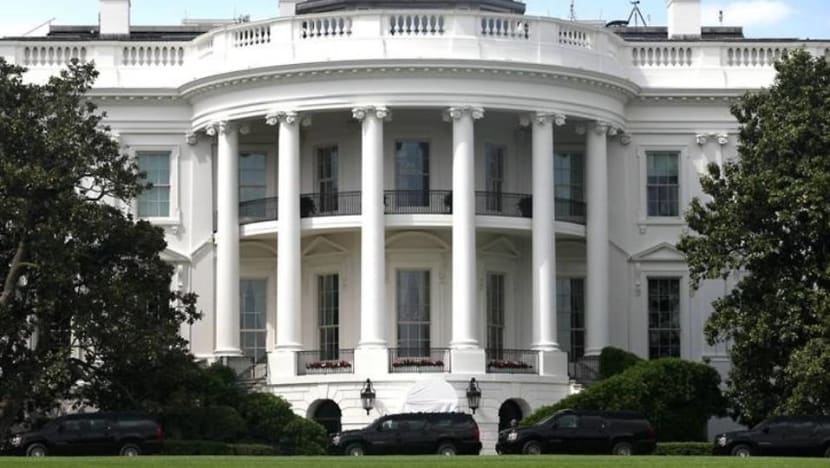commentary Commentary
Commentary: What to expect as PM Lee Hsien Loong heads to the White House
Prime Minister Lee Hsien Loong will head to the White House to call on a US President with growing foreign and domestic challenges. Jaime Ho, Chief Editor, Channel NewsAsia Digital News discusses what may be on the agenda.

US President Donald Trump's motorcade arrives at The White House. REUTERS/Zach Gibson/Files
SINGAPORE: Following an earlier meeting in July on the sidelines of the G20 Leaders’ Summit in Hamburg, and a phone-call in August, Prime Minister Lee Hsien Loong will head to the White House on Oct 23 for the first time since President Donald Trump’s inauguration in January.
His visit will likely see a mix of two strains of discussions: reassurances of business as usual, when it comes to the continued US strategic and economic commitment to Asia, Southeast Asia and its relationship with Singapore; and a touch of business, to add definition to the economic relationship between the two countries.
Context, however, is king. And the backdrop to the timing of PM Lee’s visit is mixed.
For a President prone to distraction, there is much on Trump’s plate. Domestically, apart from the perennial drama of the Administration’s drive for immigration and tax reform, it remains to be seen how issues ranging from the Administration’s response to Hurricane Maria in Puerto Rico, to dealing with the aftermath of the mass shooting in Las Vegas will be resolved by the time Mr Lee lands in Washington.
On foreign and trade policy, the situation is little better.
In typical manner, Trump threw the nation’s foreign and security establishment into a flurry last Thursday, with an off-the-cuff comment during a photo opportunity with US military leaders that the event was a “calm before the storm".
Two days later, Trump followed up with more direct reference to what he might have been talking about, saying that “only one thing will work” with Pyongyang, given that past Administrations have failed in their negotiations.
On trade, two key areas of uncertainty revolve around the US’s commitment to NAFTA and the US-Korea FTA (KORUS). Re-negotiations of NAFTA are ongoing, with strong fears that talks could still collapse, prompting an ultimate US withdrawal.
On KORUS, Seoul has effectively been coerced into re-negotiations, from which there is little prospect that the Koreans will come off better.
Internally, the Administration’s troubled state remains chronic, particularly as manifested in the seemingly intractable rift between Trump and his Secretary of State Rex Tillerson. With Trump already publicly undercutting his chief diplomat on key foreign policy issues such as North Korea, speculation on a Tillerson resignation has refused to go away.
These distractions, coupled with a foreign policy apparatus that is still very understaffed, will no doubt have created deep anxiety with foreign friends.
On the other hand, in an important gesture, Trump has already committed to travelling to Asia from Nov 3 to 14 for what will be his longest time away from home since taking office. He will head to the Philippines for the ASEAN and East Asia Summits (EAS), to Vietnam for APEC, and have important stopovers in Japan, Korea and China.
Mr Lee will therefore visit Washington at an important time, and will likely seek to provide input on the issues that Trump will have to address during his Asian tour – from North Korea to expectations for the ASEAN, EAS and APEC summits. Indeed, as incoming chair of ASEAN, Singapore will be in a unique position to talk about prospects for the region.
Being Trump’s first introduction to the nuances and rituals behind these key pillars of Asian diplomacy, it will clearly be in Singapore’s interest to ensure that his interest and commitment are maintained ahead of Singapore’s ASEAN chairmanship.
It is a role that past US Presidents and Administrations have come to seek and appreciate from Singapore’s leaders. For Mr Lee, and indeed all other world leaders, one challenge now is how far he is able to reach out to a President who is known to keep his own counsel.
SO WHAT COULD BE ON THE TABLE?
Discussions will likely range widely, from the strategic to policy levels, involving some degree of business deals.
Looking from Washington, Walter Lohman, Director of the Heritage Foundation’s Asia Studies Centre, suggested to me that Mr Lee will travel to Washington wanting “to know that Trump has a strategy for Asia and that strategy encompasses America’s traditional security commitment to the Western Pacific and an economic component that is about more than trade remedies and enforcement".
Especially seen in the light of the US withdrawal from the Trans-Pacific Partnership (TPP), and uncertainty over NAFTA and KORUS, Singapore will be eager to hear from the Administration of a continued US security and economic commitment to Asia.
It is a concern that has been voiced elsewhere as well. Speaking to me last week, Republican Member of Congress and Chair of the Singapore Congressional Caucus Bradley Byrne said that in his conversations with Singapore’s leadership – he has heard “their interest in making sure that America doesn't pull back”.
“I don’t think we are,” he added.
Byrne went on to provide reassurance that “I don't think anyone should be concerned that there's any lessening in the importance that we place on the relationship with Southeast Asia in general and Singapore in particular.”
A similarly unambiguous reaffirmation from the White House will be needed.
At the same time, it will also be key for Trump’s economic and trade policies, as a reflection of these strategic interests, to be refined and clarified, especially given uncertainty following the US withdrawal from the Trans-Pacific Partnership (TPP), and now over NAFTA and KORUS renegotiations.
Also speaking to me recently, Ted Yoho the Chairman of the Subcommittee on Asia and the Pacific in the House Committee on Foreign Affairs suggested that “Singapore is watching our trade deal with South Korea. If we back up … if Singapore and the ASEAN region see us pull away, that creates more doubt.”
THE ART OF THE DEAL
Even with the hope that the Trump White House will provide such strategic and bilateral reassurances, Trump will also look to circling back to his primary concern: Jobs for Americans.
If recent visits to the White House are anything to go by, this is not something lost on foreign leaders.
When Indian Prime Minister Narendra Modi visited in June, Trump pointed to a “recent order of 100 new American planes, one of the largest orders of its kind, which will support thousands and thousands of American jobs".
Headlining Vietnamese Prime Minister Nguyen Xuan Phuc’s visit to the White House in May were business deals as well – with the Vietnamese leader announcing that he would sign deals for goods (primarily high-tech products) and services worth some US$15 billion to US$17 billion.
Similarly, when Prime Minister Najib Razak headed to the White House, both sides issued a joint statement, which welcomed the signing of deals between Malaysia Airlines and Boeing worth as much as US$4 billion.
There is no word on announcements that will be made when Mr Lee visits Washington, but Singapore is fortunate to be already well-placed to make its economic case, starting first with a trade balance in the US’s favour.
The strength of the US-Singapore economic relationship, and the jobs that it has brought to the US is something that Congressman Byrne is keenly aware of.
VT MAE, a company established as part of the ST Engineering family is now the third largest private-sector employer in his district of Mobile in Alabama, according to Byrne. The Congressman says that company now employs as many as 1,500 people.
The fact that bilateral economic ties have translated back into American jobs will therefore be a key fact that Trump will want to highlight.
Despite the inherent uncertainties and unpredictability that may now characterise bilateral relationships with Washington, it is an unavoidable reality that its partners will have to work with.
For Lohman, it is not insurmountable. Speaking of how friends and allies in Southeast Asia may have made adjustments within this first year of the Trump Administration, he admitted, “I think for the first six months they were very worried. Now just apprehensive. They’ve identified patterns and ways to work with the Administration.”
On Washington’s part, Lohman added that “to its credit, the Administration has made several gestures to show it cares". Indeed, the messages that came early with Vice-President Mike Pence’s visit to the region, plus Defence Secretary James Mattis’ attendance and remarks at June’s Shangri-La Dialogue reaffirming the US’s “enduring commitment” to the region based on strategic interests and values of free markets, have been key gestures.
As Lohman admitted, however, it’s “never enough”, and “the bar is especially high for Trump”.
That is no bad thing, and as Mr Lee heads to Washington, both sides will be making preparations to deliver on these high expectations to reaffirm convergent interests between the two countries on areas of bilateral cooperation and regional concern.














